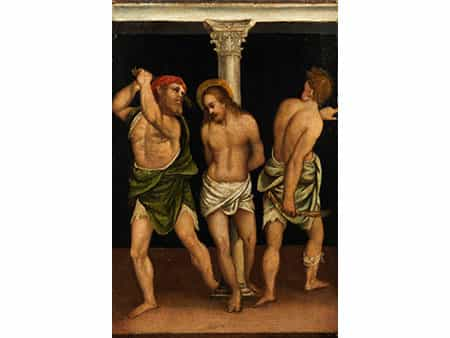Ricerca Amico Aspertini nell’asta
Dipinti XVI - XVIII secolo
giovedì, 22 settembre 2016
» rimettere
Il Vostro Art Agent personale

Siete interessati alle opere di Amico Aspertini?
Volentieri Vi teniamo aggiornati, quando le opere di Amico Aspertini verranno offerte in una delle nostre prossime aste.
Vi preghiamo di accettare la nostra politica sulla privacy
882
Amico Aspertini,
ca. 1474 Bologna – 1552
GEISSELUNG CHRISTI Öl auf Holz.
46,5 x 30,5 cm.
Prezzo del catalogo € 30.000 - 50.000
Prezzo del catalogo€ 30.000 - 50.000
$ 32,400 - 54,000
£ 27,000 - 45,000
元 234,600 - 391,000
₽ 2,984,700 - 4,974,500
Die Infrarot-Reflektographie zeigt die darunterliegende Vorstudie, die von sicherer Hand gezeichnet und kohärent mit der zeichnerischen Technik von Amico Aspertini ist.
Dieses Gemälde, das bis vor kurzem fast in Vergessenheit geraten war, hat ermöglicht, den Werkekatalog von Amico Aspertini hinsichtlich seiner kleinformatigen religiösen Darstellungen zu erweitern. Anscheinend gibt es nur eine weitere von ihm gemalte Darstellung des gegeißelten Heilands, nämlich das Fresko im Bogen des Eingangs zur Sant’Agostino Kapelle in der Kirche San Ferdinando in Lucca. In beiden Fällen wählte Aspertini ein klassisches Darstellungsschema, also symmetrisch und zentrumsbezogen, mit einer Marmorsäule, an die Christus gefesselt ist, welche das Bild genau in zwei analoge Teileabschnitte untergliedert. Die szenische Darstellung beschränkt sich auf das Wesentliche, hingegen konzentriert sich der Maler vollends auf den Ausdruck und vermeidet Überflüssiges und Dekoratives, mit Ausnahme des korinthischen Kapitells. Die minimale Gestik der beiden Folterknechte, die ergebene Nüchternheit des Gesichtsausdrucks des Heilands und das Fehlen der Geißelungsspuren auf seinem Körper machen aus diesem Bild ein höchst privates Objekt zur Meditation über die Bedeutung der Passionsgeschichte. Wie stets hat Aspertini auch hier – er besaß tiefes archäologisches Wissen – die Figuren nach klassischen Skulpturen modelliert. Wie Giovanna Degli Esposti in der Beschreibung des Gemäldes anlässlich der großen monographischen Ausstellung in Bologna 2008-2009 sagte kann dieses Gemälde gut mit anderen Werken von Aspertini verglichen werden, zum Beispiel den „Drei männliche Akte“, Kunsthalle Hamburg, die ebenfalls Ende der ersten Dekade des 16. Jahrhunderts entstanden sein dürften.
Literatur:
D. Scaglietti Kelescian, Nuovi dipinti di Amico Aspertini, in „Scritti di storia dell’arte in onore di Jürgen Winkelmann“, Neapel 1999, S. 325-333.
M. Faietti, Amico’s friend: Aspertini and the Confraternita del Buon Gesù in Bologna, in „Drawing Relationship in Northen Italian Renaissance Art. Patronage and Theories of Invention“, a cura di G. Periti, London 2004, S. 54.
G. Degli Esposti, scheda in Amico Aspertini 1474-1552. Artista bizzarro nell’età di Dürer e Raffaello, Ausstellungskatalog (Bologna, 27. September 2008 - 11. Januar 2009) a cura di A. Emiliani, D. Scaglietti Kelescian, Mailand 2008, S. 194, Nr. 53.
Ausstellung:
Amico Aspertini 1474-1552. Artista bizzarro nell’età di Dürer e Raffaello, a cura di A. Emiliani, D. Scaglietti Kelescian, Bologna, 27. September 2008 - 11. Januar 2009, Nr. 53. (1070902) (21)
Amico Aspertini,
ca. 1474 Bologna – 1552
THE FLAGELLATION OF CHRIST
Oil on panel.
46.5 x 30.5 cm.
An underlying preliminary sketch is revealed with infrared-reflectology. The sketch is executed with confidence and is consistent with Amico Aspertini’s drawing technique.
The painting, which up until recently had almost been forgotten, has made it possible to extend Aspertini’s œuvre with regards to small-format religious paintings. Only one other depiction of the Flagellation of Christ by the artist is believed to exist, namely a fresco in the arch of the entrance to the Sant’Agostino Chapel in the San Ferdinando Church, Lucca. In both cases Aspertini chose a classic composition. As Giovanna Degli Esposti pointed out in her description of the painting when it was shown at the great monographic exhibition in Bologna in 2008-2009, it compares easily with other works by Aspertini such as Three male nudes (Kunsthalle, Hamburg) which was probably also created towards the end of the first decade of the 16th century.
Literature:
D. Scaglietti Kelescian, “Nuovi dipinti di Amico Aspertini”, in Scritti di storia dell'arte in onore di Jürgen Winkelmann, Naples 1999, pp. 325-333.
M. Faietti, “Amico’s friend: Aspertini and the Confraternita del Buon Gesù in Bologna“, in G. Periti (ed.), Drawing Relationship in Northern Italian Renaissance Art. Patronage and Theories of Invention, London 2004, p. 54.
A. Emiliani and D. Scaglietti Kelescian (eds.) Amico Aspertini 1474-1552. Artista bizzarro nell’età di Dürer e Raffaello, exhibition catalogue (Bologna, 27 September 2008 - 11 January 2009), Milan 2008, p. 194, no. 53.
Exhibitions:
Pinacoteca Nazionale, Bologna, Amico Aspertini 1474-1552. Artista bizzarro nell'età di Dürer e Raffaello, 27 September 2008 - 11 January 2009, no. 53.
This object has been individually compared to the information in the Art Loss Register data bank and is not registered there as stolen or missing.
Il Vostro Art Agent personale
Volete essere informati quando nelle nostre prossime aste un’opera di Amico Aspertini viene offerta? Attivate qui il Vostro Art Agent personale.
Vi preghiamo di accettare la nostra politica sulla privacy
Volete comprare un′opera di Amico Aspertini?
Il Vostro Art Agent Comprare in Private Sale Date delle aste
I nostri esperti sono felici di assistervi personalmente nella Vostra ricerca di opere d′arte
Volete vendere un′opera di Amico Aspertini?
Consegnate ora Vendita privata FAQ
Le vostre consegne sono sempre benvenute. Il nostro team sarà felice di assistervi personalmente in ogni fase trattative. Aspettiamo le vostre chiamate.
Contattate i nostri esperti
further catalogues Mobili e arredamento | Sculture e oggetti d'artigianato artistico | Argenti e porcellane | Due collezioni d'avorio | Scatoline e miniature | Arte russa | Dipinti XIX secolo | Arte moderna | Arte asiatica | Orologi da polso e orologi | Borse e valigie | Dipinti XVI - XVIII secolo | Gioielli | Hampel Living














